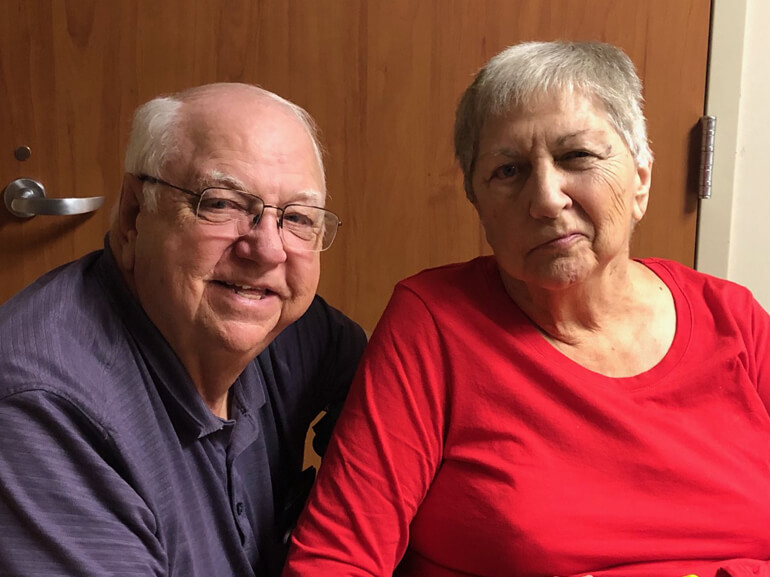Vivian's story

For the love of cooking
Vivian Browning, an avid gardener who loves the outdoors, was having a perfect October day gardening followed by a walk along a nearby stream. But the 76-year-old lost her footing, slipped on wet rocks and hit her head. She went to the local emergency room where doctors assessed her, found nothing unusual and sent her home.
Two days later, Vivian awoke in the night. She felt ill, but could not get out of bed. Her husband, Chester called 911. He tried to help her stand and noticed her face was drooping — classic sign of a stroke.
At the local emergency room, a scan showed a blockage, but the treatment team could not administer the clot-busting medication tPA because Vivian was on a blood thinner. A medial helicopter flew her to Penn State Health Milton S. Hershey Medical Center approximately five and a half hours after the onset of her stroke.
The treatment team unsuccessfully tried to remove the blockage. Chester and their four adult children gathered at her bedside, fearful she might not make it.
To everyone’s surprise Vivian pulled through and, 10 days later, doctors told the family she’d stabilized enough for them to consider the next level of care. They chose Penn State Health Rehabilitation Hospital.
However, she was not out of the woods. She returned to the main hospital twice for complications, including pneumonia.
A physical medicine and rehabilitation consultation was ordered. The rehab team encouraged Vivian again to complete her program. Doctors put her on a feeding tube to improve her nutritional intake and reduce the risk of aspiration. Vivian was ready to give rehabilitation another shot.
For Vivian, the third time was the charm. Her short-term goals were to eat safely and begin to walk, which she was able to do with the help of physical, occupational and speech therapy.
When she arrived, respiratory intervention was needed, including procedures to clear secretions from her throat. That procedure helped her turn the corner and begin making progress.
Vivian also worked with speech therapy who introduced thickened liquids and pureed foods into her diet. The team gave her small amounts at a time, asking her to swallow twice with each bite — ensuring her mouth was clear before introducing more food. They did this in a structured environment, with limited distractions allowing Vivian to focus. Over time, she was able to consume four ounces each of pureed food and thickened liquids with each meal. Due to continued cognitive deficits, it was not safe for Vivian to eat all her food by mouth so she still received some through her feeding tube. A big part of her therapy was providing Chester with training and education on how to manage her nutritional needs and the feeding tube once they returned home.
Meantime, Vivian worked with physical therapists to help her resume walking. She started by using a walker that could support her weight and would adjust to her height. It was an important milestone as it allowed Vivian to use her upper body to assist with trunk control, which helps hold the body upright when sitting or moving. Over time, core control improved and she progressed to a rolling walker.
Because of memory challenges, constant repetition with standing and walking was the key to Vivian’s physical therapy. Therapists would teach her each step and the order in which to do them multiple times.
Vivian’s occupational therapists retrained her on managing daily living activities: how to transfer from her bed to a chair, how to shower and dress herself, how to compensate for the weakened side of her body. Once her team discovered Vivian’s love of cooking, they worked the kitchen into her therapy from navigating kitchen tools and cabinets to retraining her on how to make pudding. All key items in preparing for her return home.
Therapists wove air hockey into Vivian’s treatment, which ratcheted up the fun while helping with balance and arm movement. They also focused on caregiver training with Chester to prepare for when she was discharged home.
Recreational therapy carried through to musical instruments; Vivian loved playing the piano. Tickling the ivories boosted her cognitive processing and hand function — while singing along bolstered her speech and articulation. Lastly, card games were also worked into her day. Playing in a seated position and reaching for the cards helped with her balance and arm function, respectively.
Vivian credits her husband as a key part of her recovery. He was there by her side around the clock, encouraging her and learning everything he’d needed to care for Vivian once they returned home. In fact, he only returned home twice during Vivian’s stay. Most nights he could be found sleeping beside her on a cot.
Vivian was discharged on December 28. She was walking 60 feet with a rolling walker and assistance — just enough to exit the hospital doors to Chester’s awaiting car, ready to take her home.
Vivian’s future plans include continued speech and physical therapy in an outpatient setting, she said. Eventually, Vivian and Chester plan to visit family in Oregon. The family has a room set up just for them, and they will continue enjoying retirement together.